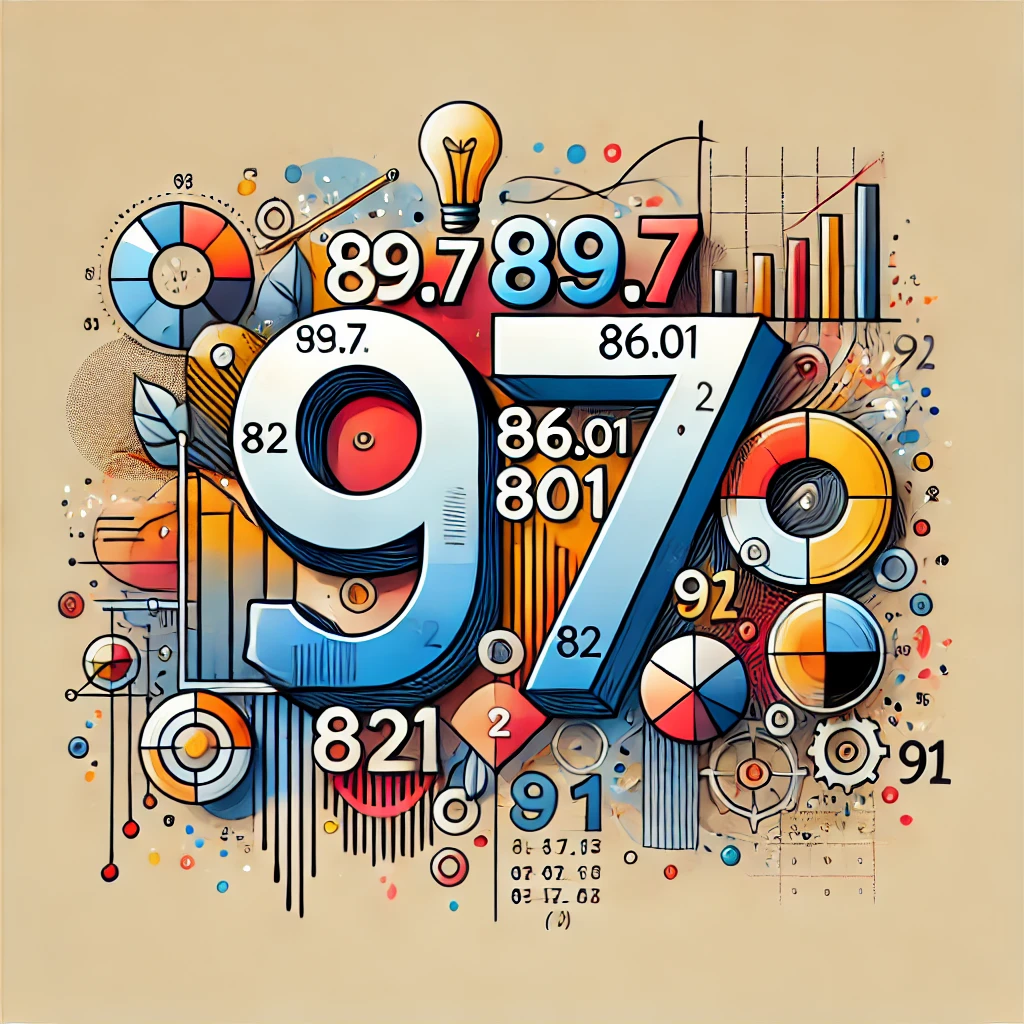Numbers like 89.7, 86.01, 82, and 91 are more than just random digits. In various fields, from education and business to healthcare and data analysis, these figures hold important meanings. Understanding 89.7 86.01 82 91 helps make informed decisions, track progress, and assess outcomes. Whether you’re a student, a professional, or simply curious, let’s dive into the significance of these numbers and how they impact different areas of life.
Decoding 89.7, 86.01, 82, and 91: What Do They Mean?

Numbers can represent success, performance, and precision. Let’s break down each of these figures:
- 89.7: Often seen in academic or performance settings, this number generally signifies high achievement. Scoring 89.7 typically reflects strong competence, usually corresponding to a B+ or A- grade.
- 86.01: Precision comes into play with numbers like 86.01. This figure is common in science, finance, or detailed statistical analysis, where small decimal points can make a big difference. It can be an indicator of accuracy in a measurement or performance metric.
- 82: This number often represents competence with room for improvement. An 82 is typically seen as a good but not excellent score, usually corresponding to a B in educational grading.
- 91: Excellence is the hallmark of the number 91. It suggests mastery and is often tied to top-tier performance, such as an A- or A grade, indicating an individual’s superior grasp of a subject or skill.
Understanding 89.7 86.01 82 91 can provide deeper insights into performance evaluations, personal achievements, and organizational success across a variety of domains.
The Mathematical and Statistical Relevance of the Numbers
In the world of mathematics and statistics, numbers like 89.7, 86.01, 82, and 91 are essential benchmarks for evaluating performance, trends, and predictions.
- 89.7 could represent a percentage of success in surveys or performance evaluations. It’s a near-perfect score, showing that the vast majority of respondents or subjects are achieving well.
- 86.01 reflects high precision. This number might appear in research studies where accuracy is crucial, such as temperature readings or financial projections.
- 82 often shows up in mean calculations in surveys or assessments, representing solid but not exceptional performance.
- 91 is often a percentile ranking, denoting that someone or something is performing in the top 9% of a given population or group.
In statistical analysis, these numbers—89.7 86.01 82 91—help researchers and businesses draw insights, create models, and make predictions that influence future decisions.
Contextual Applications of the Numbers in Various Fields
Each of these numbers has specific applications depending on the field. Let’s look at how 89.7 86.01 82 91 play out in education, business, science, and healthcare.
Education
- 89.7: Represents high achievement in school or university exams. This score could significantly boost a student’s GPA, increasing chances for scholarships or academic awards.
- 86.01: Typically appears in standardized tests, where precision is key. A slight difference in scores, even down to decimal points, can shift a student’s percentile ranking.
- 82: Denotes good performance but also highlights the need for improvement. For students, an 82 signals that with some effort, a higher level of mastery is within reach.
- 91: Reflects academic excellence, often leading to honors or placement in advanced courses. Students with scores like 91 often qualify for competitive programs or internships.
Business and Corporate Metrics
In business, numerical performance indicators drive strategy and success. Here’s how 89.7 86.01 82 91 can influence key metrics:
- 89.7: Could represent customer satisfaction rates. For a business, an 89.7% satisfaction score reflects a highly positive reception from clients, helping shape future marketing and customer retention strategies.
- 86.01: Represents a more precise metric, like an employee performance score or revenue growth rate. Small differences in such numbers can influence big decisions, such as bonuses or promotions.
- 82: Might show adequate performance in quarterly reviews or market research, pointing out that there’s room for growth but overall health is stable.
- 91: Denotes excellent performance in business metrics, such as top-tier employee productivity, high market share, or successful product launches.
Science and Healthcare
In fields like healthcare and research, precision is essential. Here’s how 89.7, 86.01, 82, and 91 are relevant:
- 89.7: Could represent the success rate of a new medical treatment or the effectiveness of a drug in clinical trials.
- 86.01: Often seen in research statistics, where every decimal point matters. For instance, a clinical study showing a drug’s effectiveness at 86.01% signals a significant breakthrough.
- 82: In healthcare, this might denote a patient’s recovery rate after a treatment or procedure, indicating steady but not flawless results.
- 91: Reflects near-perfect outcomes in treatments or medical trials, possibly influencing wider adoption of the treatment method.
Psychological and Behavioral Influence of Numbers
The numbers we encounter can deeply affect our behavior, self-perception, and motivation. Here’s how 89.7 86.01 82 91 impact individuals psychologically:
- 89.7: Almost a perfect score, this number can inspire a sense of pride and accomplishment. For students or employees, it often serves as motivation to maintain or improve performance.
- 86.01: The precision of this number, especially in fields like finance or healthcare, may increase stress or pressure to be perfect. Small deviations in such exact figures can lead to high-stakes decisions.
- 82: This number often represents “good, but not great.” It might prompt self-reflection and push people to strive for improvement.
- 91: For those who achieve a score of 91, there’s a strong sense of validation and success. It symbolizes a top-tier performance that fosters confidence and motivates continued excellence.
Comparative Analysis of Numerical Data Across Domains
Comparing how 89.7 86.01 82 91 are used across different sectors offers a better understanding of their flexibility. Here’s a brief comparison:
- Education: These numbers reflect students’ academic success, from good (82) to excellent (91).
- Business: In the corporate world, they represent performance indicators like sales growth, customer satisfaction, and employee productivity.
- Science and Research: These numbers are often tied to accuracy and precision in data, with even decimal points (like 86.01) holding significant value.
- Healthcare: They represent patient outcomes, treatment success rates, and procedural effectiveness, with numbers like 89.7 and 91 signaling high levels of effectiveness.
Applications in Emerging Technologies and Data Analytics
As technology advances, 89.7, 86.01, 82, and 91 also have increasing relevance in fields like data analytics, AI, and machine learning. Here’s how:
- Predictive Analytics: These numbers are crucial in building predictive models. For example, a score of 89.7 might represent the success rate of a prediction made by an AI model.
- Machine Learning: In machine learning, precise numbers like 86.01 represent the accuracy of models, with even minor decimal changes having significant consequences for prediction accuracy.
- Data Analytics: Data-driven decision-making relies heavily on metrics, with numbers like 82 and 91 offering insights into trends, helping businesses forecast future performance.
How Numbers Influence Data-Driven Decision-Making
In today’s data-driven world, numbers like 89.7, 86.01, 82, and 91 are crucial for decision-making across all sectors. Whether in finance, healthcare, or education, these numbers guide strategies, help allocate resources, and assess progress. Businesses might decide to invest in a project with a projected 91% success rate, or a student may push harder after achieving an 82, knowing they’re close to excellence.
Conclusion: The Power of Numbers in a Data-Driven World
Numbers like 89.7, 86.01, 82, and 91 play a significant role in various fields. From education to healthcare, they help us measure success, track progress, and inform decisions. By understanding the meaning behind these numbers, we can better navigate a world increasingly reliant on data for driving choices.
In short, numbers are more than just digits—they shape our everyday lives and have far-reaching effects on everything from personal achievements to large-scale corporate strategies. Embrace the significance of 89.7 86.01 82 91 to unlock the power of data-driven decision-making.






















+ There are no comments
Add yours